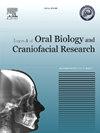Comparative analysis of viability, proliferation, and mineralization potential of human pulp and osteoblastic cells exposed to different bioceramic endodontic sealers
Q1 Medicine
Journal of oral biology and craniofacial research
Pub Date : 2025-01-01
DOI:10.1016/j.jobcr.2025.01.008
引用次数: 0
Abstract
Background
The present study aimed to compare the viability, proliferation, and mineralization potential of human dental pulp cells (hDPCs) and osteoblasts cell line (Saos-2) after exposure to AH Plus® Bioceramic (AHP-B), Bio-C® Sealer (BIO-C), NeoMTA Plus® (NEOMTA-P), and MTA-FILLAPEX® endodontic sealers (MTA-F).
Methods
All materials were prepared according to the manufacturer's instructions. Before exposing the cells, we measured the release of calcium ions (Ca2+) from the dental materials to the culture media once Ca2+ can trigger signaling pathways. After that, hDPCs and Saos-2 were exposed to the sealers for MTT assay to assess the cell viability and wound healing to evaluate the cell proliferation. To investigate the potential of mineralization, we assessed the alkaline phosphatase activity and calcium deposition by Alizarin red staining. Statistical analysis was performed using Two-way ANOVA for calcium release and wound healing assays and One-way ANOVA for other assays, with post-test Bonferroni correction. The results were significant when p < 0.05.
Results
The sealers released diverse concentrations of calcium at different times. The hDPCs viability and proliferation were low in the AHP-B group at 24h of exposure (NEOMTA-P ∼ BIO-C ∼ CT > AHP-B > MTA-F), distinct from the osteoblastic cells (NEOMTA-P ∼ AHP-B ∼ CT > BIO-C > MTA-F) and (proliferation: AHP-B > NEOMTA-P ∼ CT > BIO-C > MTA-F). The ALP activity, an early marker of osteogenesis, was higher in hDPCs exposed to NEOMTA-P, while the osteoblastic cells showed higher ALP when exposed to AHP-B.
Conclusion
AHP-B, NEOMTA-P, and BIO-C stimulated osteogenesis in hDPCs and Saos-2 cells, with marked differences between groups. AHP-B showed an improved early stimulation of osteoblastic cells, while hDPCs were more responsive to NEOMTA-P.

不同生物陶瓷牙髓密封材料对人牙髓和成骨细胞活力、增殖和矿化潜力的比较分析。
背景:本研究旨在比较暴露于AH Plus®生物陶瓷(AHP-B)、Bio-C®密封剂(Bio-C)、NeoMTA Plus®(NeoMTA - p)和MTA-FILLAPEX®牙髓密封剂(MTA-F)后人牙髓细胞(hDPCs)和成骨细胞(Saos-2)的活力、增殖和矿化潜力。方法:所有材料均按生产厂家说明书制备。在暴露细胞之前,我们测量了钙离子(Ca2+)从牙科材料释放到培养基中,一旦Ca2+可以触发信号通路。之后,将hDPCs和Saos-2暴露于密封剂中进行MTT试验,评估细胞活力和伤口愈合情况,评估细胞增殖情况。为了研究矿化潜力,我们用茜素红染色法测定了碱性磷酸酶活性和钙沉积。对钙释放和伤口愈合试验采用双因素方差分析,对其他试验采用单因素方差分析,并进行试验后Bonferroni校正。结果:封口剂在不同时间释放不同浓度的钙。暴露24h时,AHP-B组hDPCs的活力和增殖较低(NEOMTA-P ~ BIO-C ~ CT > AHP-B > MTA-F),与成骨细胞(NEOMTA-P ~ AHP-B ~ CT > BIO-C > MTA-F)和(增殖:AHP-B > NEOMTA-P ~ CT > BIO-C > MTA-F)不同。在暴露于NEOMTA-P的hDPCs中,ALP活性(成骨的早期标志)更高,而在暴露于AHP-B的成骨细胞中,ALP活性更高。结论:AHP-B、NEOMTA-P、BIO-C均能促进hDPCs和Saos-2细胞成骨,组间差异显著。AHP-B对成骨细胞的早期刺激有所改善,而hDPCs对NEOMTA-P的反应更明显。
本文章由计算机程序翻译,如有差异,请以英文原文为准。
求助全文
约1分钟内获得全文
求助全文
来源期刊

Journal of oral biology and craniofacial research
Medicine-Otorhinolaryngology
CiteScore
4.90
自引率
0.00%
发文量
133
审稿时长
167 days
期刊介绍:
Journal of Oral Biology and Craniofacial Research (JOBCR)is the official journal of the Craniofacial Research Foundation (CRF). The journal aims to provide a common platform for both clinical and translational research and to promote interdisciplinary sciences in craniofacial region. JOBCR publishes content that includes diseases, injuries and defects in the head, neck, face, jaws and the hard and soft tissues of the mouth and jaws and face region; diagnosis and medical management of diseases specific to the orofacial tissues and of oral manifestations of systemic diseases; studies on identifying populations at risk of oral disease or in need of specific care, and comparing regional, environmental, social, and access similarities and differences in dental care between populations; diseases of the mouth and related structures like salivary glands, temporomandibular joints, facial muscles and perioral skin; biomedical engineering, tissue engineering and stem cells. The journal publishes reviews, commentaries, peer-reviewed original research articles, short communication, and case reports.
 求助内容:
求助内容: 应助结果提醒方式:
应助结果提醒方式:


